With the continuously evolving healthcare industry, patient experience has become more crucial than ever for all healthcare organizations and it is essential for healthcare organizations to ensure a great experience for patients with high-quality care and the best treatment. But how will you know whether your patients are satisfied with their experiences with your healthcare services? Here comes the role of patient feedback.
Patient feedback is a powerful way to collect patient insights by listening to the voice of patients at various points of the patient journey and use them to drive quality improvement, enhance patient safety, and foster a culture of continuous care and improvement. It is a great way to assess how well your healthcare professionals are able to satisfy your patients with treatment and health services, identify points of friction or frustration which patients go through while availing your healthcare services, and take action to improve their overall patient experience.
In healthcare, the experience of the patient is the ultimate measure of quality. We must listen to our patients and their families to understand their needs and continuously improve our services.
- Dr. Donald Berwick, former Administrator of the Centers for Medicare and Medicaid Services (CMS)
A notable example of the impact of patient feedback can be seen with the Cleveland Clinic. This renowned healthcare brand implemented a rigorous patient feedback system that collected real-time patient opinions. By closely analyzing this feedback, Cleveland Clinic identified specific areas needing improvement, such as wait times and communication with medical staff. As a result, they were able to implement targeted changes that significantly enhanced the patient experience, leading to higher patient satisfaction scores and a stronger reputation for exceptional care.
In this article, we will explore how patient feedback is important for healthcare providers, how you can collect it, and how patient surveys and patient feedback apps can help you measure and improve patient satisfaction and ultimately grow your business. Let's get started!
Measure Patient Feedback and Satisfaction👩⚕️
Create your healthcare surveys and questionnaires to collect feedback from patients in real time.

What is Patient Feedback?
Patient feedback is the information of patients' opinions, evaluations, and perceptions about their experiences with a hospital, clinic, or any healthcare centre. It can be about any aspect or particular service given by the healthcare providers or about the overall treatment, or stay in the hospital. Patient feedback can be patients' opinions about:
-
Appointment booking process
-
Waiting time
-
Interactions with the doctors
-
Interactions with other medical staff
-
Cleanliness of the healthcare facility
-
Medical care facilities at the hospital
-
Diagnosis of the doctor
-
Overall treatment and medication provided to the patient
-
Patient safety
-
Billing processes and charges of the medical services
- Assistance provided for Mediclaim insurance claim
-
Pharmacy and availability of medicines
-
Food at the hospital cafeteria
Patient feedback serves as a valuable component when it comes to improving the overall healthcare quality. It should be collected at various touchpoints of the patient journey in different types of healthcare institutions like hospitals, clinics, aged care, and pharmacies, via a variety of channels such as email and SMS sent via a business text app.
Watch this webinar to learn how to gather feedback effectively throughout the patient journey and elevate the overall care experience: Gathering Feedback Across the Patient Journey
Patient Feedback in Hospitals and Clinics
Patient feedback in hospitals and clinics is essential for enhancing the quality of care and patient satisfaction. By collecting feedback at various touchpoints, healthcare providers can identify areas for improvement and ensure a positive patient experience.
For Inpatients
Inpatient feedback helps to improve the overall experience of your inpatients and ensures that the hospital meets their needs effectively to make their overall experience of treatment and hospital stay better. The following touchpoints are crucial for collecting patient feedback.
1. Admission Process - Collect patient feedback just after patient admission in the hospital to collect insights about the experience of patients and their family members regarding the admission process of your hospital. It will help you identify friction points or issues which they may face to get the patient admitted in the hospital like long waiting times or complex processes.
2. Medical Tests - Collect feedback about patients experiences of getting various tests in your hospital. Ensure that patients are not prescribed too many unnecessary medical tests which causes an unnecessary burden on their pockets. Gauge patient satisfaction with staff support, prices of tests, and availability of test reports on time.
3. Hospital Stay and Treatment - Gather patient feedback about their overall experience of their treatment and stay in the hospital. Collect insights about hospital cleanliness, staff support and conduct, food provided, experience with the doctors, their diagnosis of illness, and their overall inpatient experience at the hospital.
4. Discharge - Collect feedback about patients' and their family members' experiences with the discharge process. Cover points like complexity of the discharge process, time taken for discharge, bill payment, and assistance provided in getting medical insurance claims.
5. Post-discharge Follow-up - Also collect feedback about the post-discharge follow-up consultations with the doctor.
For Outpatients
Collecting feedback from outpatients is essential for improving the quality of services provided and ensuring that outpatient visits are smooth and efficient with satisfying interactions with the doctors and other staff. Key touchpoints for collecting feedback include:
1. Appointment Booking - Collect feedback on the ease of booking appointments, including the availability of convenient times, user-friendliness of the booking system, and the responsiveness of the staff.
2. Check-in at reception - Gather feedback on the check-in process, including wait times, the efficiency of the reception staff, and the clarity of the information provided during check-in.
3. Post-Consultation with Doctor - Collect feedback on the outpatient consultation experience, including the clarity of the doctor's communication, the thoroughness of the examination, and any follow-up care instructions provided.
Patient Feedback in Aged Care
Collecting feedback in aged care facilities is crucial for ensuring that residents receive the best possible care and that their families are satisfied with the services provided. Here are the key touchpoints for gathering feedback:
1. Admission Process - Collect feedback on the admission process to understand the ease and clarity of the procedures involved in admitting a new resident to the aged care facility.
2. Daily care activities - Gather feedback on daily care activities to ensure that residents are satisfied with the quality of care, the attentiveness of staff, and the availability of recreational activities.
3. Health Assessments - Collect feedback on health assessments to gauge satisfaction with the thoroughness of medical check-ups and the communication of health information to residents and their families.
4. Family or Visitor Feedback - Gather feedback from family members and visitors to understand their perspectives on the quality of care provided and their satisfaction with the facility's environment and policies.
5. Staff Feedback - Collect feedback from staff to identify areas for improvement in working conditions, training needs, understanding of patients' requirements, and overall job satisfaction, which can indirectly affect patient care.
6. Discharge Process - Collect feedback on the discharge process to ensure that it is smooth, efficient, and adequately supported by the staff.
Patient Feedback in Pharmacies
Feedback in pharmacies is vital for improving service quality and ensuring patient satisfaction with the pharmacy's offerings. Here are the key touchpoints for gathering feedback:
1. Prescription Fulfillment - Collect feedback on the prescription fulfillment process, including the accuracy of the prescriptions, wait times, and professionalism of the pharmacy staff.
2. Medication Consultations - Gather feedback on medication consultations to understand patient satisfaction with the advice provided by pharmacists, including the clarity and helpfulness of the information about medications.
3. Purchase Process - Collect feedback on the purchase process to ensure that it is efficient, with minimal wait times, and that the staff is courteous and helpful.
4. Billing Process - Collect feedback on the billing process to identify any issues with billing accuracy, clarity of billing statements, and ease of processing payments or insurance claims.
Importance of Patient Feedback
Patient feedback provides invaluable insights into the experiences and emotions of patients, allowing healthcare providers to address issues and enhance overall care instead of your patients simply walking away. However, the significance of patient feedback extends far beyond merely resolving individual complaints.
Here's a look at some of the reasons for it to be essential for healthcare providers.
1. To Foster Patient-Centric Care
Patient feedback is a critical tool for driving quality improvement in healthcare services. By collecting feedback at various touchpoints within your facility, you can identify specific issues and concerns related to the quality of care provided. This information enables you to implement targeted improvements, ensuring that similar issues do not reoccur in the future and you deliver patient-centric care.
For instance, you receive feedback about long waiting times in the emergency department of your hospital. By analyzing this feedback, you can make decisions to reorganize their triage process, significantly reducing waiting times and improving patient care.
2. To drive better patient experience and satisfaction
Patient feedback helps you measure patients' satisfaction with your healthcare services. When you collect patients' insights and utilize that feedback for patients to provide better medical care and treatment, it drastically improves patients' overall experiences and raises their satisfaction levels, which also helps to improve patient outcomes.
For instance, you run a clinic and you noticed from patient feedback that many patients felt rushed during consultations. In response, you can extend appointment times and allow doctors to spend more time with each patient and diagnose their illness better. This change can lead to higher patient satisfaction and better health outcomes, which will ultimately create a good reputation for your clinic.
3. To create a base of loyal patients and get referrals from them thereby attracting more patients
Soliciting feedback from patients demonstrates that you value their opinions and are committed to providing excellent care. This fosters a positive perception of your healthcare brand and increases patient engagement. According to recent studies in 2024, disengaged patients are three times more likely to have unmet medical needs, directly affecting loyalty. By acting on patient feedback and delivering superior experiences, you can significantly boost patient loyalty, encouraging them to consistently choose your healthcare organization for their medical needs.
Let's say you receive negative feedback about the friendliness of your staff. You can provide service training to improve patient interactions. These improved patient interactions will result in higher retention rates and better loyalty.
Loyal patients not only choose your healthcare brand over others but also tend to recommend it to other people in their known. Studies suggest that around 50% of the patients rely on personal recommendations from friends and family. Personal recommendations attract new patients into your healthcare business, which ultimately contributes to the growth of your business.
4. To boost reputation in the healthcare industry
Negative patient experiences can quickly spread through online reviews and word of mouth, damaging your reputation. Studies suggest that more than 70% of patients check online reviews before consulting a new doctor. So it is necessary to ensure that you have a good image in the industry and patient feedback helps you do that.
With the help of a good patient feedback system, you can identify satisfied and loyal patients and automatically trigger review requests redirecting them to the right platform to boost the online reputation of your hospital or healthcare centre.
5. To Set Benchmarks and Compare Patient Experience
Patient Feedback helps you set benchmarks from past patient experiences and ratings to make comparisons and track growth and improvement in terms of patient satisfaction and improvement. When you send regular surveys like relationship surveys, you get a detailed picture of patient experience and a rise or fall in patient satisfaction levels.
By using the same type of survey regularly, you can easily compare survey response data and ratings to know how patient satisfaction is improving or deteriorating. This information guides to to take the right steps to boost patient satisfaction and thus attain more business growth and success.
6. To identify areas of friction and patient frustration
Patient feedback helps you gather patients' insights regarding how they feel about the treatment, care, and healthcare facilities provided at the hospital or clinic. It helps you identify areas of friction and patient frustration like appointment difficulties, long wait times, rude staff, delayed medical reports, and cleanliness problems. Using this information, you can detect patient churn before it happens and address patient issues proactively to improve patient retention and loyalty.
With the help of robust analysis of patient feedback through AI-powered patient feedback software, you can discover beyond the basic patient sentiment and it becomes easier to identify areas of friction and patient frustration. This information guides you to take feedback-driven action to reduce patient effort and eliminate these friction and frustration areas for patients and their family members eventually reducing their effort and improving their experiences.
7. To better assess the health condition of the patients
Patient surveys provide valuable insights into patients' health conditions. By asking healthcare assessment questions, you can gather information about patients' eating habits, allergies, chronic health problems, and genetic issues. This information helps in diagnosing diseases and providing the most suitable treatment.

8. To Track the Progress of the Patients' recovery
Patient surveys can also be used while the treatment is going, in order to track the progress in the patient's health and recovery. To do this, you can integrate your survey software with your patient CRM tool so that all patient data and insights can be accessed at the same place. This helps the doctors to know how the patient's body is responding to a certain treatment. The information enables them to decide the further course of medication and treatment.

Surveys are the best way to collect patient feedback. Here are some reasons to use patient feedback surveys for collecting feedback. Let's explore them.
Why to Use Surveys to Collect Patient Feedback?
Surveys are a great way to connect with your patients and fetch the necessary information that you need to be able to provide them with better treatment and care. Here are some common reasons to use patient surveys in the healthcare industry.
1. Surveys help to track and compare patient feedback across multiple locations
Surveys allow you to gather and compare patient feedback across various locations, providing a comprehensive view of patient experiences across your entire chain of hospitals or healthcare centres.
With this feedback, you are able to identify trends, and discrepancies, and do a fair comparison of feedback ratings to identify the areas that need improvement at specific sites, ensuring consistent quality of care throughout all facilities.
2. Surveys encourage more responses through anonymity
Surveys can be designed to ensure patient anonymity, which often leads to more honest and detailed feedback. Patients are more likely to provide candid feedback when they know their identities will not be revealed, enabling you to gain a more accurate understanding of patient experiences and areas that need improvement.
3. Surveys help you make evidence-based decisions
Collecting and analyzing survey data provides you with robust information to make feedback-driven decisions for your healthcare business. By understanding patient needs, preferences, and concerns, you can implement changes that are directly informed by patient feedback, leading to more effective and patient-centred improvements.
4. Surveys enable you to monitor healthcare staff performance
Patient surveys often include questions about interactions with healthcare staff, allowing patients to are their interactions with doctors, nurses, and other healthcare staff. This helps you monitor and assess staff performance from the patient’s perspective. This feedback is critical for identifying high-performing staff, recognizing areas where additional training and improvement is needed, and ensuring that all employees contribute to a positive patient experience.
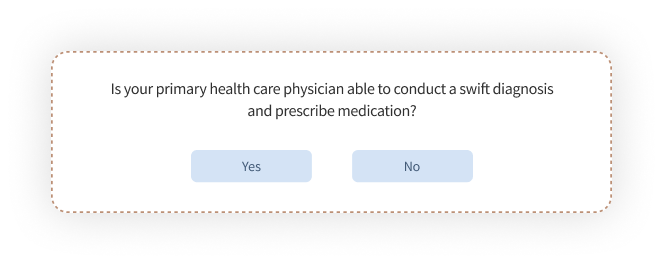
5. Surveys foster systematic and regular feedback collection
Surveys are particularly effective in establishing a structured and ongoing system for collecting patient feedback. This systematic approach ensures that feedback is not only gathered sporadically or in response to noticeable issues but is continuously obtained over time. Regular feedback collection allows you to keep a pulse on patient satisfaction, monitor trends, and quickly respond to emerging issues before they escalate.
Let's explore the ways to collect patient feedback.
How to Collect Patient Feedback at Various Touchpoints?
Collecting patient feedback effectively involves utilizing a variety of channels that align with different touchpoints in the patient journey. By strategically deploying both online and offline feedback mechanisms, you can ensure comprehensive coverage at all touchpoints and gather actionable insights to enhance patient care.

Here’s how you can optimize feedback collection at key patient journey touchpoints.
1. Arrival and Check-In
At the arrival or check-in at your hospital, clinic, aged care, or pharmacy, you can survey your patients or their family members through kisok surveys.
- Kiosk Surveys: Set up unattended kiosk devices in the reception and waiting areas. Patients or their family members can easily provide feedback while they wait.
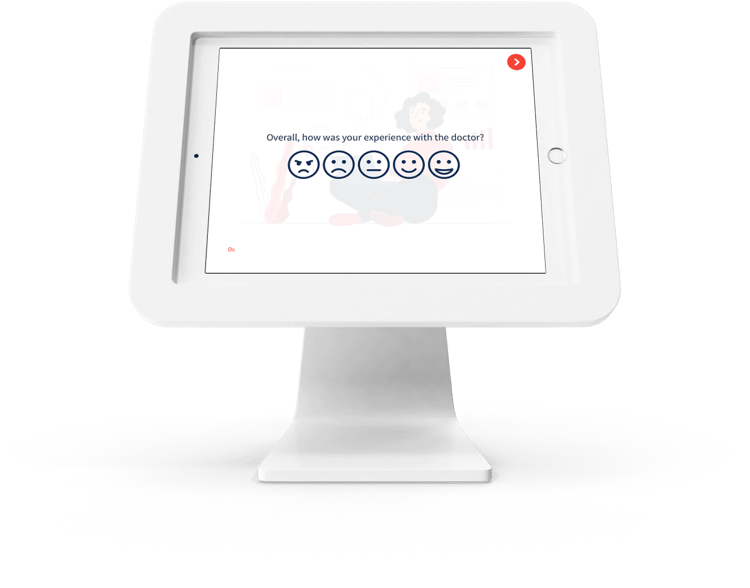
2. Post Consultation
Just after consultation with the doctor, you can use these channels to survey your patients and collect feedback about their interaction with the doctor.
- Kiosk Surveys: You can set up kiosks just outside the doctor's cabin and let your patients share their feedback immediately as they are done with the consultation.
- Mobile Devices: You can also handover mobile devices like iOS and Android tablets for patients to give feedback immediately after their consultation.

- In-Product Surveys: If you have a healthcare app, use in-app or in-product surveys to collect feedback just after a consultation.
3. Post-Treatment or Discharge
For the inpatients at your hospital or at the aged care, you can collect post-treatment or post-discharge feedback through these channels.
- Email Surveys: Send email surveys shortly after discharge. Utilize different types of emails surveys like embedded email surveys which displays the first question directly in the email body itself, email surveys with hyperlinks which are simple email invitation followed by a link to a full survey or email signature surveys which can be embedded in the email signature of follow-up communications in the form of a hyperlink or embedded survey or a survey button.
- SMS Surveys: Send an SMS survey invitation with a link to the survey a few hours after discharge. This method is convenient for quick feedback on the post-treatment experience.
4. Follow-Up Appointments
For collecting patient feedback about follow-up appointments, you can use these channels.
- Kiosk Surveys: Place kiosks in follow-up appointment areas to gather feedback on the ongoing care.
- Website Surveys: Implement feedback widgets like pop-up surveys, slide-up surveys, or feedback buttons on your website or patient portal where patients manage their follow-up appointments.
5. General Feedback and Continuous Improvement
- Website Surveys: Utilize your official website or app to collect ongoing feedback through various widgets.
- Mobile App Surveys: Integrate surveys within your mobile app for continuous feedback from users.
By identifying and targeting these specific touchpoints, you can deploy appropriate feedback collection methods that ensure comprehensive and timely insights. This approach not only helps in capturing immediate reactions but also provides a continuous stream of feedback to improve patient satisfaction and overall experience.
Let's learn how you can take action on patient feedback to improve patient satisfaction and improve the overall experience.
Taking Action on Patient Feedback
The purpose of obtaining patient feedback is to improve patient experience, which is impossible without taking action on feedback. So you must develop and work on the entire patient feedback system to not only collect and analyze patient experience feedback but also take action on it. Here are some steps you should take to leverage feedback to improve patient experience and ultimately grow your business.
1. Gather and analyze patient feedback data
The first step is to gather and analyze feedback data through data collection forms and identify the issues your patients may be facing at various touchpoints of their patient journeys.
-
Collect patient feedback from your inpatients and outpatients through various channels at different touchpoints of the patient journey.
-
Bring the collected patient feedback data to a centralized platform. You can also integrate your feedback data in your CRM to get a 360-degree view of the patients' journeys.
-
Review patient feedback and analyze it to find your strengths, weaknesses, and areas of improvement in your healthcare services. Use features like Sentiment Analysis and Text Analysis to dig deeper into patient insights and be able to make patient-centric decisions.
2. Trigger Responses to every feedback
Always respond to every feedback from patients. Set up automatic responses thanking the patients for feedback and ensuring actions (if required) on it. But only these automatic replies will not do the whole work. You need to take further actions on feedback in order to win the trust of the patients and assure them that their health is a priority for you and you are committed to providing great care and treatment to them.
Have a dedicated team to work on patient feedback and to close the feedback loop which can understand patients' experience and its effect on their health and can respond to the patients accordingly.
-
Thank the patients who give positive feedback for appreciating your efforts to provide quality care.
-
Thank the patients with neutral feedback for responding to the survey and ask them what you can do to provide better quality care to the patients.
-
Apologize to the patients who share negative feedback for their bad experience and ask them what made them unhappy with the treatment and care they received.
3. Analyze Patient Feedback and act accordingly
The next step is to analyze the feedback data received. This involves employing advanced analytical tools and techniques to derive actionable insights from the feedback. Here’s how you can leverage AI-powered analysis:
- Use sentiment analysis to automatically categorize feedback as positive, negative, or neutral and go deeper into patient sentiments to find actionable feedback data. This helps in quickly identifying areas that need immediate attention and understanding overall patient sentiment.
- Implement text analysis to extract key themes, trends, and common issues from open-ended feedback. This helps in understanding specific areas of concern and areas where your service excels.
- Use AI-powered churn detection to identify patients at risk of leaving your practice based on their feedback. By detecting early signs of dissatisfaction, you can take proactive measures to retain these patients.
- Detect signs of patient frustration, such as repeated negative feedback or mentions of long wait times and communication issues. Addressing these frustrations promptly can significantly improve patient satisfaction.
4. Automate creating tickets as per patients' feedback and present situation
With the help of an effective patient feedback system, you can automate the process of taking action on patient feedback.
-
For positive feedback, you can redirect the respondents to a review platform and request them to share an online review.
-
For neutral or negative feedback where actions are required, have dedicated teams of medical staff to take instant action on patient feedback.
-
Engage your doctors and other medical staff to decide what can be done in particular cases to improve patient experience and health conditions.
This will help you provide better treatment to the patients and improve patient retention.
5. Take instant action wherever required
Engage with your doctors, nurses, and other healthcare staff and encourage them to take instant action on patient feedback wherever required.
-
Offer resolutions to the patients which can improve their experience or make things better for them. For instance, if somebody gets the wrong treatment or wrong diagnosis, engage with the doctors to check what can be done to reduce the bad effects on the patient's health. It can lead to inappropriate or lacking treatments worsening the patient's condition. Seeking legal guidance for misdiagnosis for critical cases, such as heart attack, is crucial for patients who've experienced these issues.
-
Try to compensate for a bad experience by offering a token of apology like a free health checkup, discounts on medicines, or a free health supplement.
-
If you find negative feedback reviews on online review platforms or social media, try connecting with the patients privately to listen to their voices and offer healthcare solutions to their issues and concerns.
6. Inform the Patients about the actions taken
When you have taken the required action or changes in your healthcare services as per patients' feedback, do inform them personally. This conveys that you take their feedback seriously and are keen to provide them with quality care and the best treatment. This induces loyalty in them towards your healthcare organization.
7. Leverage feedback data and reports to learn about new medical opportunities
Use AI-powered analytics and feedback reports to carefully observe patient feedback trends and recurring patient issues. Make decisions and changes along with incorporating patient feedback to avoid any such issues in the future. You can also discover new opportunities from the patient feedback data.
For instance, if a particular test is not available in your hospital and many of your patients have to visit other labs for that test, you can make decisions to bring the necessary medical equipment and staff to start that medical test in your hospital or healthcare centre.
Create and Send Patient Feedback Surveys with Zonka Feedback
Zonka Feedback is one of the best patient feedback software and app that you can use to create and send patient feedback forms or surveys. You can easily create surveys in minutes and use various channels to share them with your patients. Here are the steps to do so:
-
Sign up for Zonka Feedback account and go to the survey builder where you can choose a patient feedback survey from a variety of survey templates available to create a new feedback survey. These are customizable templates wherein you can modify the questions as per your survey needs.
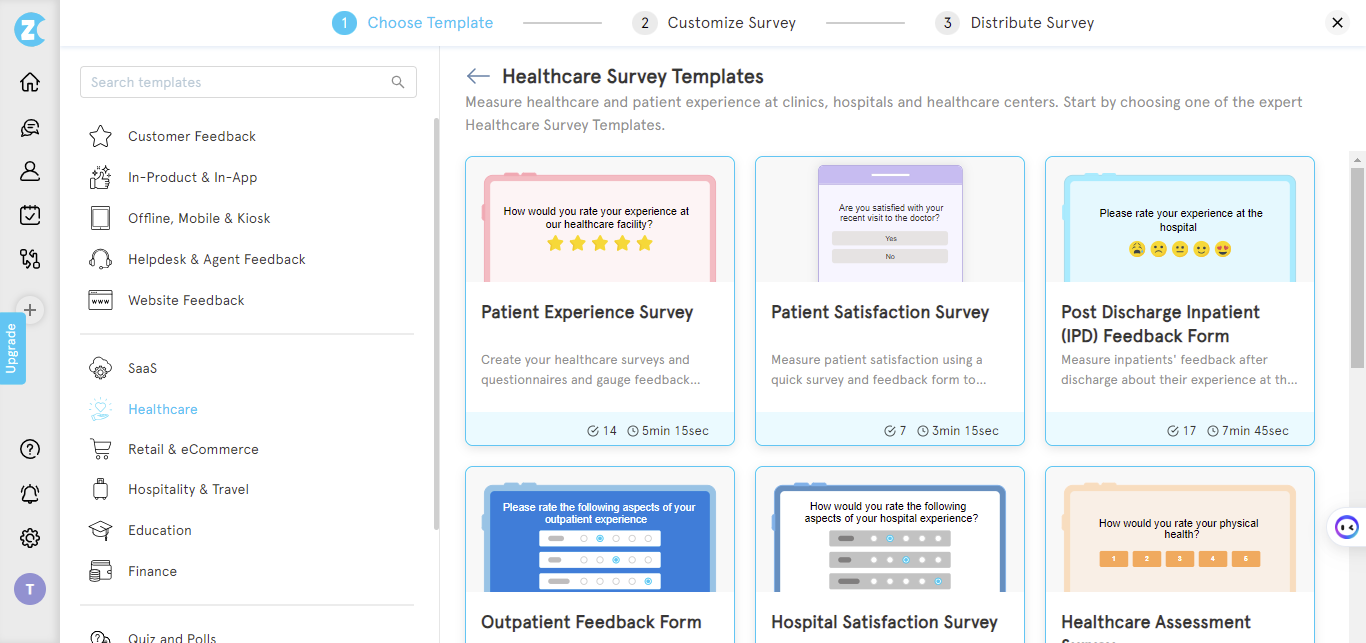
-
Choose among 30+ question types available to include in your questions and select the theme and design as per your choice. You can add survey logic, company branding, and language of your choice.
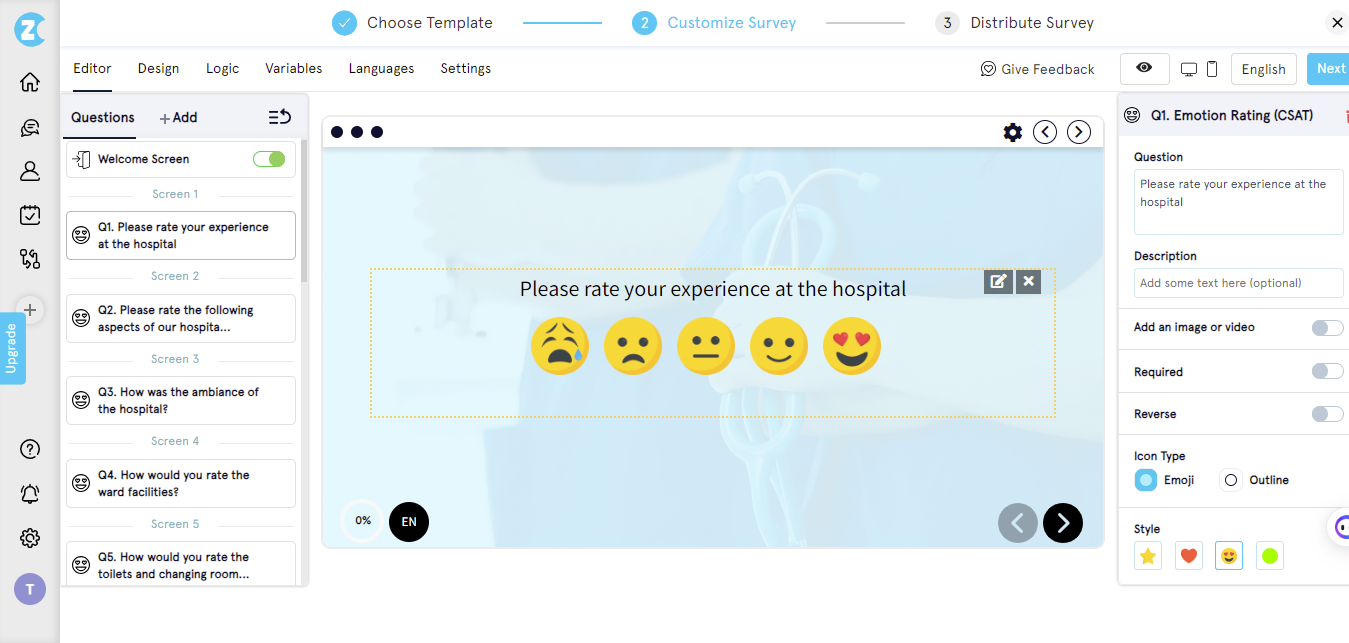
-
Use survey variables to pass additional data or information about the patients that you already have. This will make your respondents' task easier by automatically filling in the details like name, age, and other information that you already have.
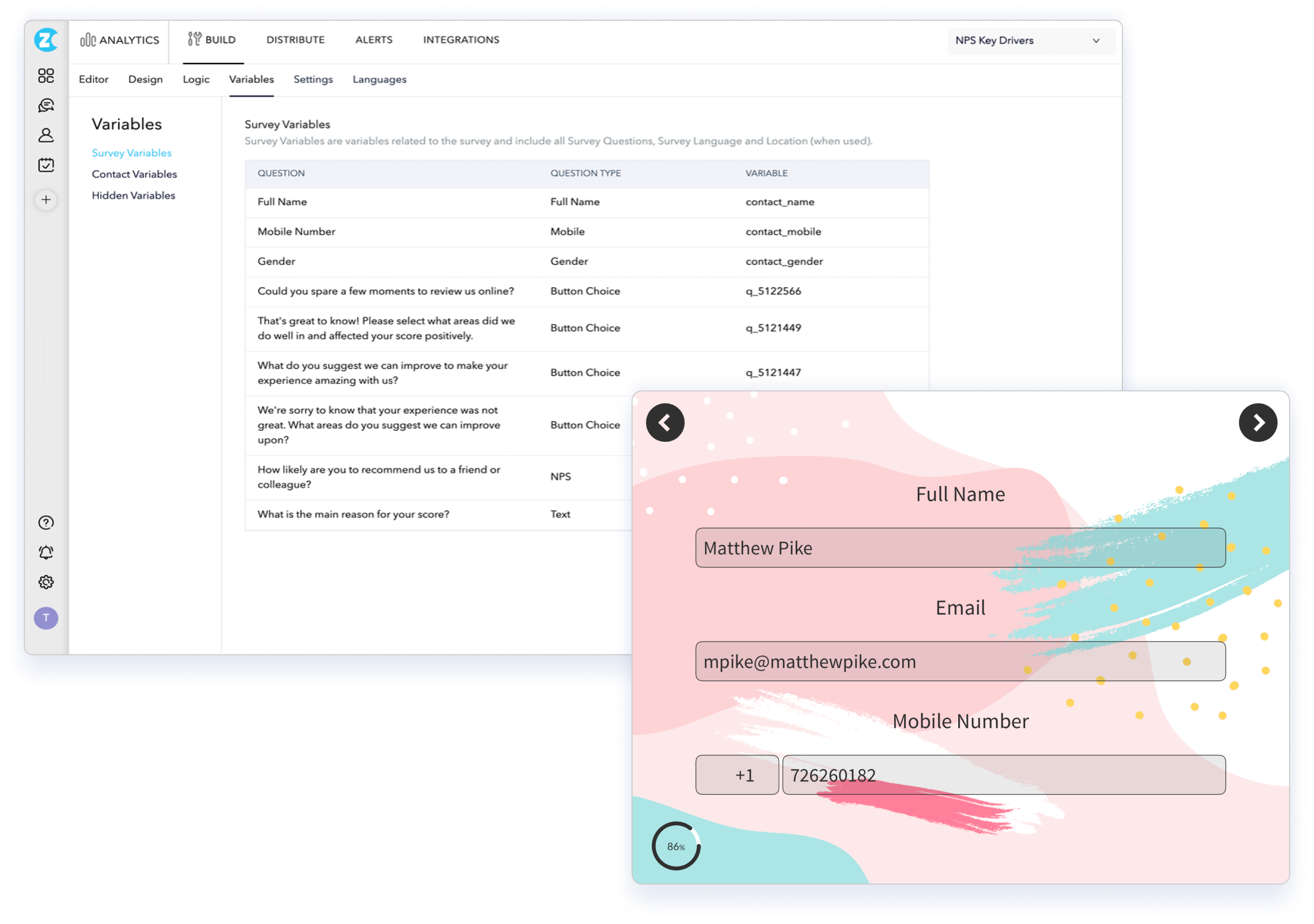
-
Send your surveys to the patients. You can choose among various channels to distribute your surveys - in-app, website, email, SMS, kiosk, iOS and Android devices.
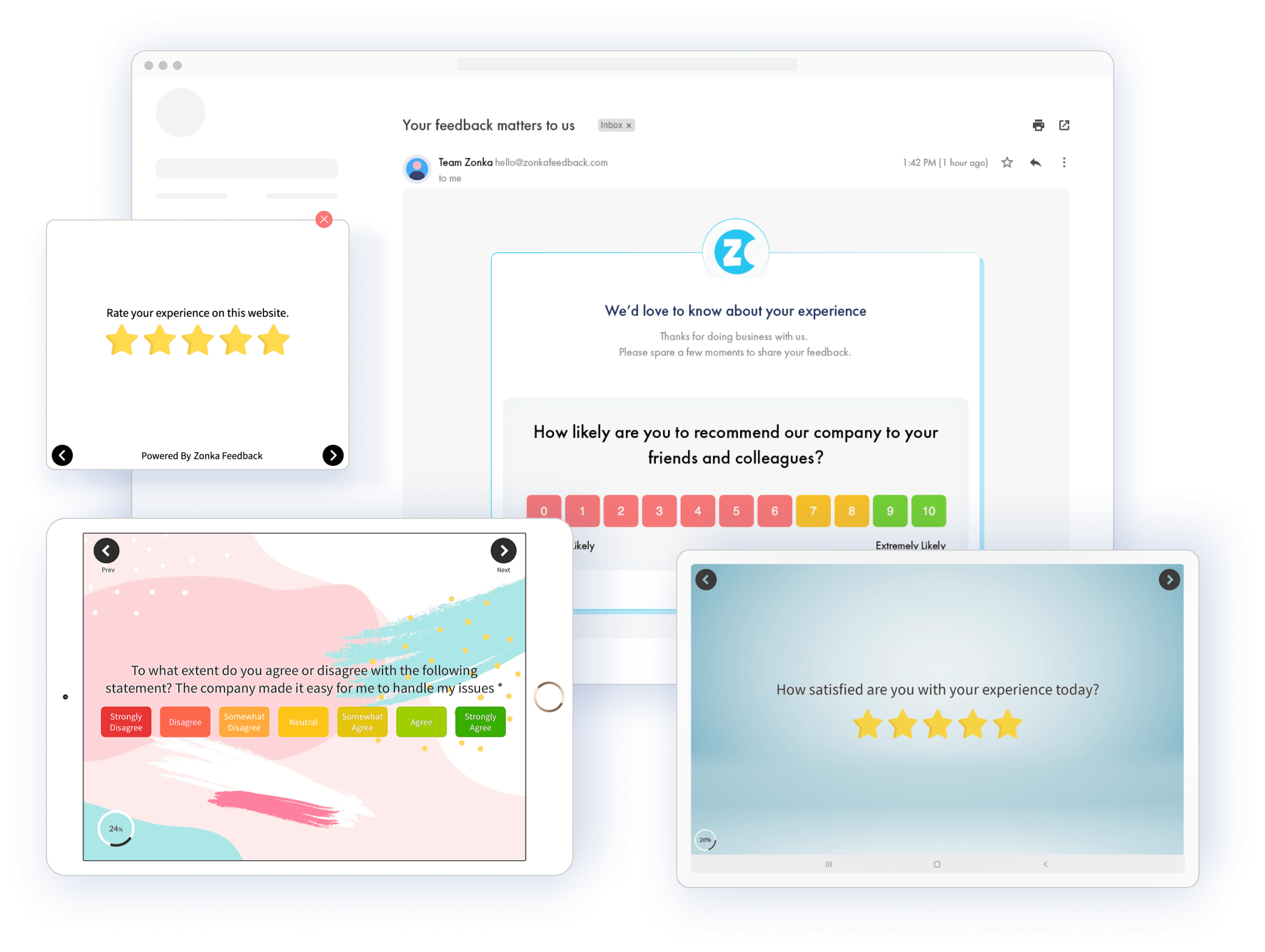
-
Use Zonka Feedback reporting and analytics to analyze the patient feedback data received through reports like trends reports, location insights reports, team performance reports, and more.
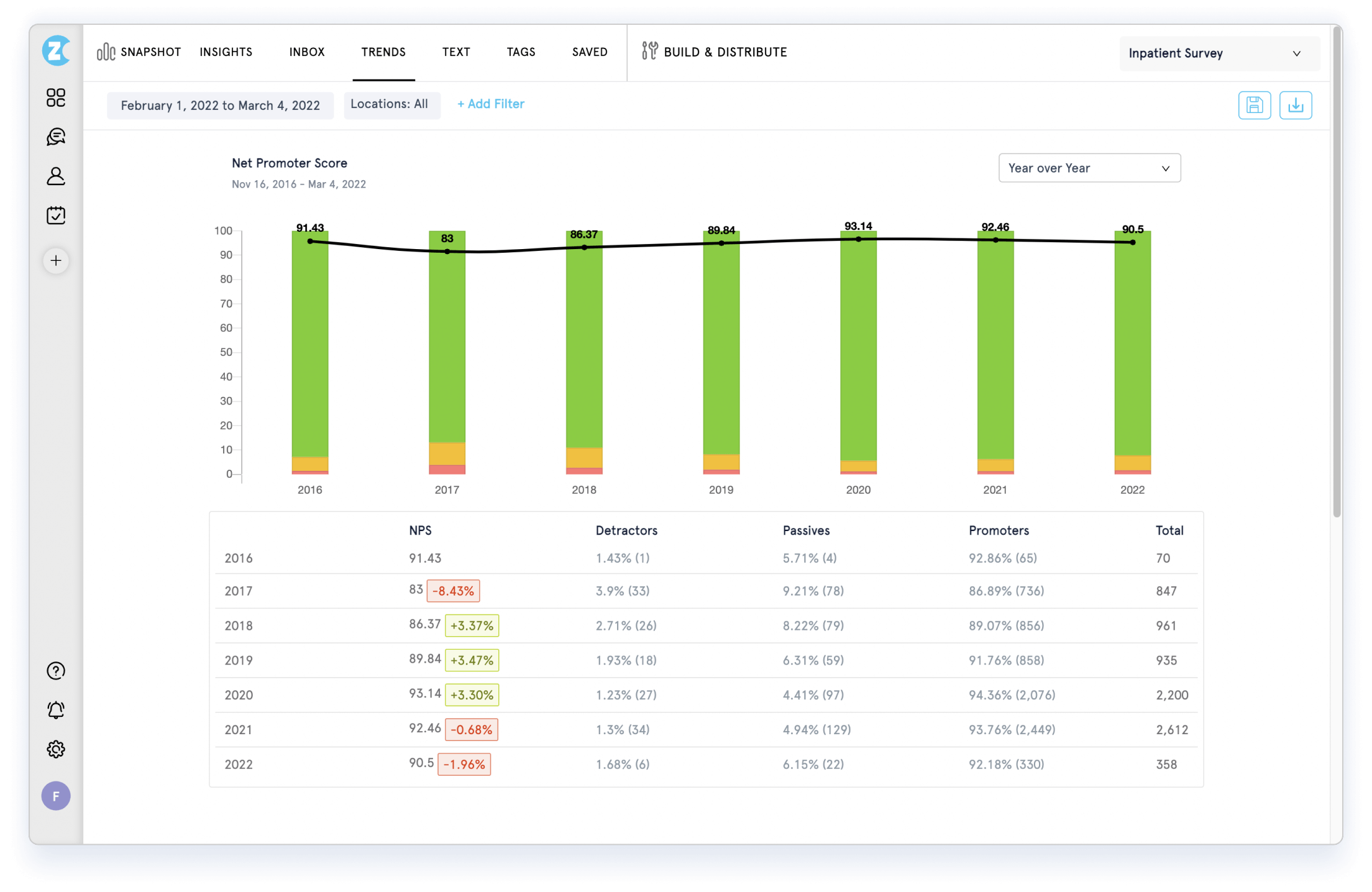
Let's review some templates that can help you in collecting feedback from your patients.
Some Examples of Patient Feedback Surveys That You Can Use
Here are some examples of patient feedback surveys that you can use to collect feedback from your inpatients and outpatients.
1. Sample Survey to Gather Inpatient Feedback
Inpatients are individuals who are admitted to a hospital and stay overnight or for an extended period for medical treatment and care.
You can use the inpatient feedback template below to create patient feedback surveys for inpatients.
2. Sample Survey to Gather Outpatient Feedback
Outpatients are individuals who receive medical treatment or care at a healthcare facility such as a hospital or clinic without staying overnight. They visit for appointments, consultations, medication or treatment; and return home the same day.
You can use the outpatient feedback template below to create patient feedback surveys for outpatients.
3. Sample Survey to Gather Doctor Feedback
Doctors or physicians are the core of your healthcare facility and patients' interactions with the doctors can make or break patient experiences.
Here is a doctor feedback template that you can use for gathering patient feedback about your doctors and know how well they are able to diagnose and treat patients.
Conclusion
It is essential to provide your patients with satisfying experiences to make your healthcare business successful. Patient Feedback is the way to understand how your patients perceive their experience with your hospital, clinic, or healthcare centre, and how satisfied they are with those experiences.
With the help of good patient feedback software, you can easily create patient surveys and share them with your patients through multiple channels to collect feedback, measure patient satisfaction, and improve the overall experiences of the patients.
Zonka Feedback is one tool that not only helps you in obtaining patient feedback but with its features like real-time alerts and notifications, notifies you with every feedback or negative feedback (as per criteria you set). This enables you to take instant action on real-time patient feedback and close the feedback loop effectively to improve patient experience and enhance patient satisfaction.
You can schedule a demo to explore more about the tool.



.jpg)


.jpg)




.png)
